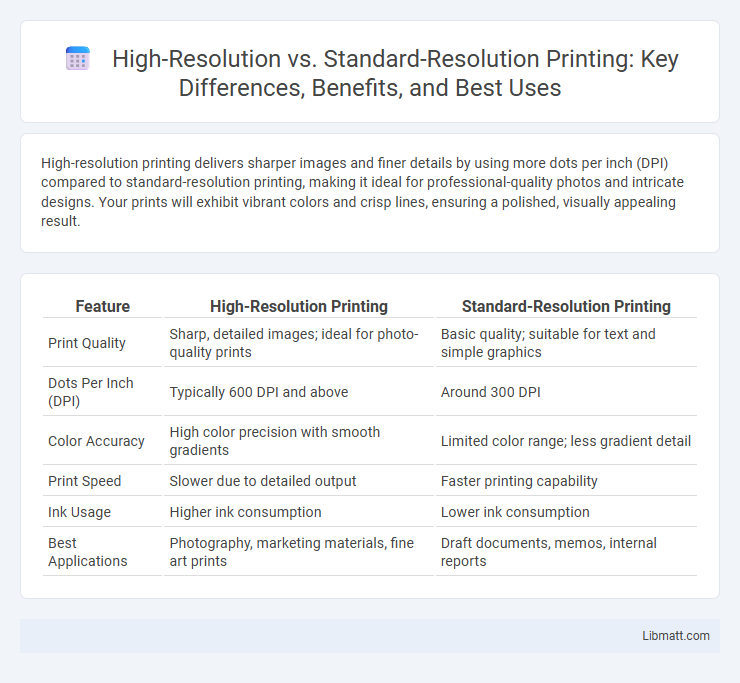High-resolution printing delivers sharper images and finer details by using more dots per inch (DPI) compared to standard-resolution printing, making it ideal for professional-quality photos and intricate designs. Your prints will exhibit vibrant colors and crisp lines, ensuring a polished, visually appealing result.
Table of Comparison
| Feature | High-Resolution Printing | Standard-Resolution Printing |
|---|---|---|
| Print Quality | Sharp, detailed images; ideal for photo-quality prints | Basic quality; suitable for text and simple graphics |
| Dots Per Inch (DPI) | Typically 600 DPI and above | Around 300 DPI |
| Color Accuracy | High color precision with smooth gradients | Limited color range; less gradient detail |
| Print Speed | Slower due to detailed output | Faster printing capability |
| Ink Usage | Higher ink consumption | Lower ink consumption |
| Best Applications | Photography, marketing materials, fine art prints | Draft documents, memos, internal reports |
Understanding Print Resolution: Basics Explained
Print resolution refers to the density of dots per inch (DPI) used by printers to create sharp, detailed images on paper. High-resolution printing typically employs 300 DPI or more, enabling finer detail and smoother color gradients compared to standard-resolution printing, which usually ranges between 72 and 150 DPI. Understanding these basics is crucial for selecting the appropriate print settings to achieve clear text, vivid graphics, and professional-quality outputs.
What Is Standard-Resolution Printing?
Standard-resolution printing typically refers to output at 300 dots per inch (DPI), offering sufficient clarity for everyday documents and basic images. This resolution balances file size and print speed, making it suitable for business reports, flyers, and internal presentations where ultra-fine detail is not critical. When choosing printing options, understanding that standard-resolution meets most general needs while high-resolution printing excels in photo-quality or intricate graphic reproductions can help optimize your print results.
Defining High-Resolution Printing
High-resolution printing refers to producing images or text at a minimum of 300 dots per inch (DPI), resulting in sharper and more detailed output compared to standard-resolution printing, which typically ranges from 72 to 150 DPI. This higher pixel density enhances print clarity, especially for photographs, fine lines, and intricate graphics. High-resolution printing is essential for professional-quality materials such as brochures, marketing collateral, and photographic prints.
Key Differences Between High-Resolution and Standard-Resolution Printing
High-resolution printing offers sharper image quality with a minimum of 300 dots per inch (DPI), while standard-resolution printing typically ranges from 72 to 150 DPI, resulting in less detail and clarity. High-resolution prints are ideal for professional photo printing, detailed graphics, and crisp text, whereas standard resolution suits basic documents and draft prints. Color accuracy and smooth gradients are significantly improved in high-resolution prints due to finer dot placement and advanced ink technology.
Image Quality: How Resolution Impacts Visual Output
High-resolution printing provides significantly finer detail and sharper images compared to standard-resolution printing, resulting in clearer and more vibrant visuals. The increased pixel density in high-resolution prints ensures smoother gradients and crisper lines, minimizing pixelation that can occur in standard-resolution outputs. Your choice of resolution directly impacts the professionalism and clarity of printed materials, especially for detailed graphics or photographs.
File Size Considerations for Different Resolutions
High-resolution printing produces significantly larger file sizes compared to standard-resolution printing due to increased pixel density and image detail, directly impacting storage and processing requirements. Standard-resolution files are more manageable for everyday documents but may lack clarity when scaled or printed in large formats. Selecting the appropriate resolution balances print quality with file size efficiency, optimizing workflow performance and resource usage.
Printing Speed and Cost Comparison
High-resolution printing generally takes longer than standard-resolution printing due to the increased detail and data processing required, impacting overall printing speed. The cost of high-resolution prints tends to be higher because of the use of more advanced ink technology, finer print heads, and increased time per page, whereas standard-resolution printing offers faster output with lower operational costs. Your choice between the two should balance the need for image quality against the desired printing speed and budget constraints.
Best Applications for High-Resolution Printing
High-resolution printing is best suited for applications requiring detailed image reproduction, such as professional photography, fine art prints, and intricate graphic designs. This printing method excels in producing sharp lines, vibrant colors, and smooth gradients, making it ideal for marketing materials like brochures and high-end product packaging. Industries including advertising, fashion, and publishing often rely on high-resolution prints to convey quality and precision.
When to Choose Standard-Resolution Printing
Standard-resolution printing is ideal for large-scale prints like banners or posters viewed from a distance, where fine detail is less critical. It reduces production time and lowers printing costs, making it suitable for budget-conscious projects. You should choose standard-resolution printing when sharpness is less important than size and cost efficiency.
Making the Right Choice: Resolution for Your Printing Needs
Selecting the appropriate resolution for printing depends on the desired output quality and purpose, with high-resolution printing providing crisp, detailed images ideal for professional photos and marketing materials, while standard-resolution suffices for everyday documents and drafts. High-resolution prints typically require a minimum of 300 DPI (dots per inch) to ensure sharpness, whereas standard-resolution printing often ranges from 150 to 200 DPI, balancing quality with faster production and lower costs. Assessing the intended use, viewing distance, and print size helps determine whether investing in high-resolution printing delivers meaningful value for your project.
High-Resolution vs Standard-Resolution Printing Infographic

 libmatt.com
libmatt.com